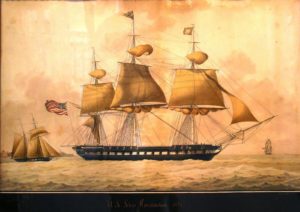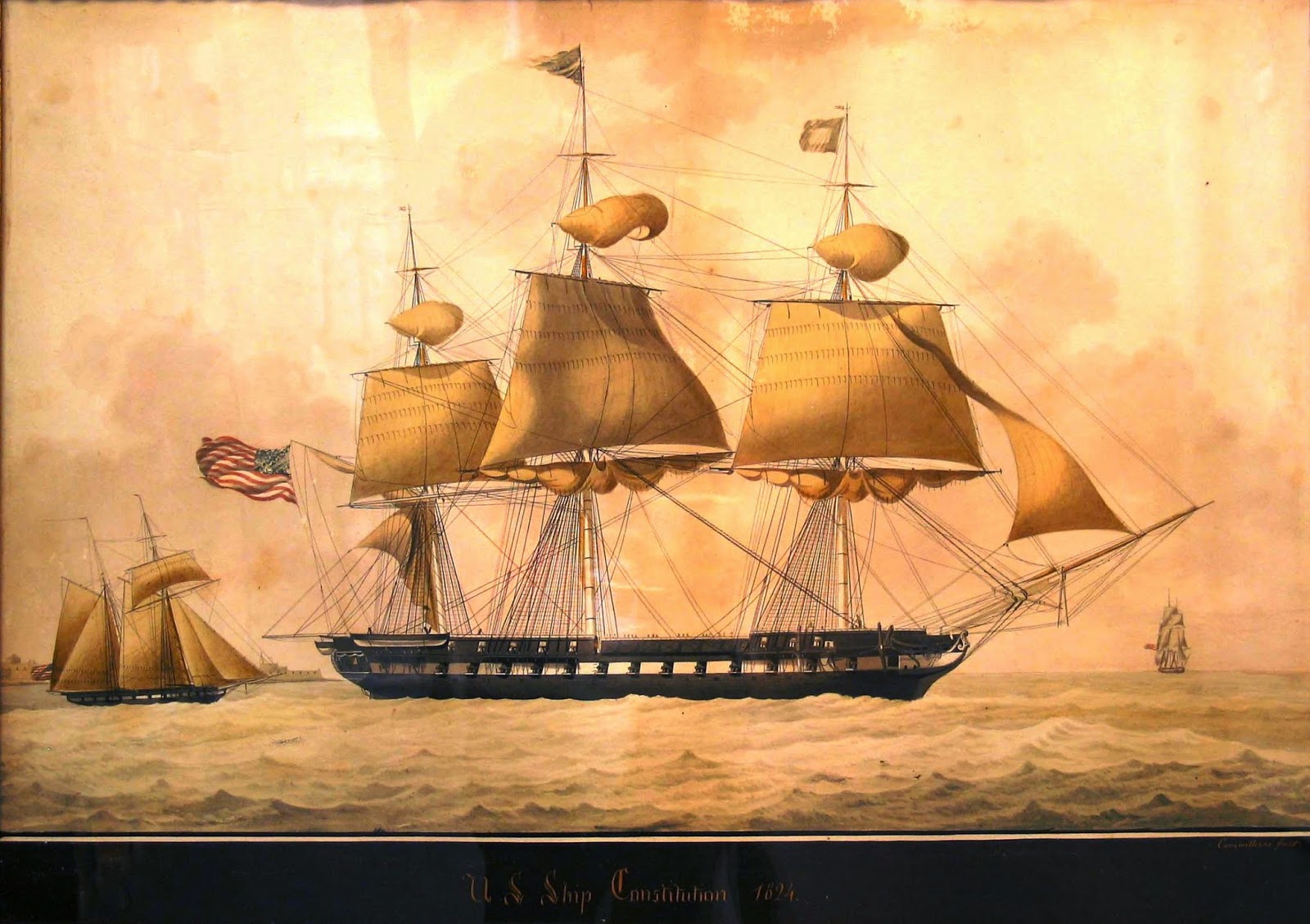The Constitution’s first major rebuild occurred in the 19th century. The ship had initially needed work between 1801 and 1803 to mend the wear and tear of the Quasi War (1798-1800), and to prepare her for her role as Commodore Edward Preble’s Mediterranean squadron flagship. After her long Mediterranean cruise, the ship required yet more repairs between 1807 and 1809. This time the work was performed in New York.
The battles with HMS Guerriere and HMS Java inflicted considerable damage on the ship, and combined with the normal degradation expected of any wooden warship, Constitution spent most of 1813 under repair at Boston. The ship needed new deck beams and waterways, deck and ceiling planking, knees, and copper sheathing. The most dramatic change came on the gun deck, which was raised 5 or 6 inches amidships. This might have done something to improve the crew’s ability to work the guns on that deck, but must have appeared awkward.
At war’s end, the ship returned to Boston and was laid up in ordinary- “mothballed” as we might say today. Surveys performed in 1815 and 1819 determined that the ship required yet more repairs before she could be placed back in active service. Happily, these surveys have provided us with the earliest surviving plans of the ship’s interior. The Navy Board of Commissioners, the group of senior officers now in charge of building and repairing the Navy’s vessels, asked for Constitution’s plans for their files, but it was determined that her original draft had been taken by Capt. Samuel Nicholson (her first captain) and had since disappeared. To make up for the deficiency, Sailing Master Charles Waldo (who lost a leg in the battle with HMS Java) drew plans of the ship’s spar deck, gun deck, and orlop deck, showing the location of the beams, knees, hatchways, and storerooms.
The surveys determined that Constitution needed some serious work to put her back into fighting trim. Remember, she was now 20 years old, at the upper end of the life expectancy for a wooden warship in the period. Her frame of sturdy live oak remained in good shape, but much of her external and internal planking, decks, beams, and masts all needed replacement. Isaac Hull, now commandant of the Charlestown Navy Yard, oversaw the repairs that lasted into 1821, but when she emerged from the hands of the Navy Yard workers, Hull could truthfully say, she was “a much handsomer Ship than she ever was.”
In 1829, Charles Morris prepared a “Statement of Repairs made upon the Frigate Constitution in 1820 & 1821.” This outlined all of the work done on the ship:
Rail, all new
Strings & Bulwarks all new
Plank between the ports inside & out, all new
Channells, all new
Strakes of plank below ports ten new
New timbers – most of the Top Timbers & Stantions [sic] new, some of the upper
futtocks new, Counter Timbers all new
Beams of Gun & Spar Decks, all new
Knees for Gun deck, about one half new
do “ Spar do, all new
Deck Plank – Spar & Gun Decks, all new – Birth deck, part new
Water Way on Gun & Spar decks, all new
Clamps of Gun & Spar decks, all new
Galleries, Head, Cutwater, & Carved work on Stern, all new
Spirketings of Birth & Gun decks, news
Ceiling in Hold, repaired
Plank on Stern, new
Bottom plank, some plank new
Gun Carriages new, /were made some years previous but had not been used
Carronade beds & Slides, repaired
Capstain,[sic] repaired
Caulking, new throughout
Copper, new
Joiners work – magazines new, Store room on fore & after orlop repaired
Ward Room & Steerage, about two thirds new, Cabin, & al[l]
other Joiners work, new
Mast & Spars – a new Bowsprit, 3 new Topmasts, 3 new Top Gallt masts,
3 lower, & 3 Topsail yards, new –
Boats, all repaired
A propelling machine made – [a man-powered contraption designed to propel the ship with paddlewheels against wind and tide]
What the list didn’t record was that yard workers discovered two 32lb round shot embedded in the hull- a souvenir of her last battle with HMS Cyane and HMS Levant. These were removed with the surrounding timber and sent to Washington, where they were placed on display in the Commissioners’ office.
The ship headed back to the Mediterranean in May 1821, and in 1824 artist Nicholas Cammillieri captured her off Malta. He rendered her with great precision, and we can see some of the changes made during the Boston refit. The bow and quarter galleries have been altered, with much of her earlier decorative work replaced, and she now has a paint scheme popular in the 1820s and 1830s- the gun stripe is carried up and all the way around the bow. The sheer or curvature of the hull and decks has been flattened as a result of repositioning the deck beams and gun port timbers. Whether she was now “much handsomer” is a matter of opinion, but she was now strong and sound enough to face another decade of active service.


The Author(s)
Matthew Brenckle
Research Historian, USS Constitution Museum
Matthew Brenckle was the Research Historian at the USS Constitution Museum from 2006 to 2016.
